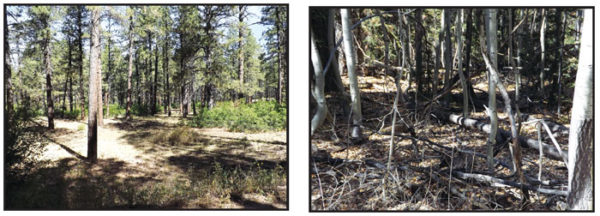
On left, the forest in the Boggy Draw vicinity shows the results of past logging, thinning and grazing. There is very little fuel for fires. On the right, in the Haycamp area of the national forest near the old Wagon Road, fuel build-up is increasing, roads are blocked off and travel restrictions prevent fuelwood gathering to reduce fuel loading. A fire here would cause great resource damage. Photo by Dexter Gill.
Where was all the smoke in the skies coming from recently? Well, mostly from Montana, Oregon and Washington, but later we had our own wildfire in the Boggy Draw area above Dolores. Started small, but the Forest Service decided to let it burn to clean up and restore some natural conditions, and it ended up being over 1,400 acres. Why did this not end up like so many other disastrous wildfires? Very simply, the area has historically been heavily logged to harvest the old dying pines, then later thinned and the slash collected for home fuelwood, burned and cleaned up and with livestock grazing use continuing . The area had been well managed with roads, trails and well used! This has resulted in very little fuel accumulation to support the larger disastrous wildfires while benefitting wildlife, livestock, water production, recreation and economy.
This is a good example of the benefits of economic management. The recent fire was beneficial in maintaining and improving what had been established by past historical management actions. Yes the smoke was irritating and even debilitating to many with breathing difficulties, but the reality is that we will always have fire in the forest and range lands, so we must choose between having lots of uncontrollable smoke and wasting resources or lesser amounts of controllable fire and smoke saving and improving resources. The fires can be a management tool for beneficial results or an uncontrolled disaster to the resources and communities.
I remember the days when we used fire regularly as a tool, in the time of year when it was easily contained and with not so much smoke generated. Unfortunately some people didn’t like any smoke, and dreamed of a utopian environment where it was always pristine with bunny rabbits frolicking with Bambi and there were no nasty woodsmen or hunters and ranchers. However, they did like the wood for their houses and verandas to sit on while barbecuing the filet mignon after spending time relaxing in their hot tub with a glass of wine from the local vineyard. As a result, the rise of the movement to “protect the environment” was born through selfish ignorance and using trickery to establish laws restricting management and use of the forests and range lands. As the disastrous fires have become more common the blame is being placed on “man-made climate change” (a farce), on past management, use and especially fire protection efforts. That is like blaming the nation’s epidemic of obesity on climate change, the farmers and supermarkets for providing too much food. The doctors are complicit for not providing a magic elixir to prevent the obesity from ever happening.
I took a drive through part of the Boggy fire and viewed unburned areas to view the fuel conditions and then some burned areas where it demonstrated simple cleaning maintenance with no lasting damage, except to the oak brush in places, which was a very desirable result. The only thing that could have been better would be that the area could have been burned a month later with less smoke, control and management costs. So why not do it that way? Well, to have a prescribed burn requires preparing an environmental analysis, costing months of personnel time and salaries, and meeting unrealistic air quality criteria with the possibility of an escaped burn costing even more and putting fire fighters’ lives in danger. So when forest management and use has been done well and a late-season fire occurs naturally, it can be left to burn without all those costs of an EA. One thing that is important to be aware of is that this burn was within a previously well-managed and used area. Much of the rest of the forest is not in this well-managed condition. The wilderness and roadless designated areas (which are the majority of the San Juan Forest) are developing heavy fuel loads and the road access for use and protection is being reduced and even eliminated. When the next fire occurs the local forest may look like the drive over Wolf Creek – beautiful for hiking and recreating in, right? It would be better to shoot for putting the local forest in managed conditions that benefit from the natural occurring wildfires and prescribed fires to maintain their health and economy.
What can be done? How about local control over management instead of a shadow government group 2,000 miles away? The forest must be actively managed for maximum health, protected from wasteful wildfires, insects and disease and used for local needs, economy and recreational improvement Did you know that the State of Colorado is larger than the United Kingdom? In the UK (State), they have many “National Parks, which include forests, ranges, fields, private lands, even towns, all of which are governed and run by the local entity that would be kin to our counties! There is not a shadowy group in Hungary controlling what the UK does with its forests and parks even though they were all part of the European Union similar to our United States. As many have said, the smallest local form of government is the most efficient and best form of government. The control and management of all the lands and resources of the counties belong with the counties.
Dexter Gill is a retired forest manager who worked for private industry, three Western state forestry agencies, and the Navajo Nation forestry department. He writes from Lewis, Colo.

